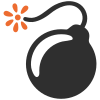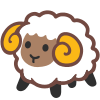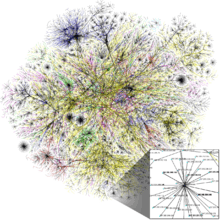Emoji
| Emoji | |
|---|---|
| Symbol sets | Emoji |
| Assigned | 1,088 code points |
| Unicode version history | |
| 1.0.0 | 78 (+78) |
| 3.0 | 80 (+2) |
| 3.2 | 88 (+8) |
| 4.0 | 96 (+8) |
| 4.1 | 111 (+15) |
| 5.1 | 115 (+4) |
| 5.2 | 142 (+27) |
| 6.0 | 858 (+716) |
| 6.1 | 871 (+13) |
| 7.0 | 975 (+104) |
| 8.0 | 1,016 (+41) |
| 9.0 | 1,088 (+72) |
| Note: These counts are for emoji that are single Unicode characters;[1][2] many more emoji are composed of sequences of two or more characters.[3] Emoji were first defined in Unicode 6.0, and pre-6.0 characters were only defined as emoji in 6.0 or later. | |
Emoji (Japanese:
Originating on Japanese mobile phones in the late 1990s, emoji have become increasingly popular worldwide since their international inclusion in Apple's iPhone, which was followed by similar adoption by Android and other mobile operating systems.[5][6][7] Apple's OS X operating system supports emoji as of version 10.7 (Lion).[8] Microsoft added monochrome Unicode emoji coverage to the Segoe UI Symbol system font in Windows 8 and added color emoji in Windows 8.1 via the Segoe UI Emoji font.[9] The first international Emojicon conference was held in San Francisco, California on November 4, 2016. Emojicon 2016
Originally meaning pictograph, the word emoji comes from Japanese e (絵, "picture") + moji (文字, "character"). The resemblance to the English words "emotion" and "emoticon" is purely coincidental.[10]
History
Emoji were initially used by Japanese mobile operators, NTT DoCoMo, au, and SoftBank Mobile (formerly Vodafone). These companies each defined their own variants of emoji using proprietary standards. The first emoji was created in 1998 or 1999 in Japan by Shigetaka Kurita,[11] who was part of the team working on NTT DoCoMo's i-mode mobile Internet platform. Kurita took inspiration from weather forecasts that used symbols to show weather, Chinese characters and street signs, and from manga that used stock symbols to express emotions, such as lightbulbs signifying inspiration.[12][13][14] The first set of 172 12×12 pixel emoji was created as part of i-mode's messaging features to help facilitate electronic communication, and to serve as a distinguishing feature from other services.[5] Kurita created the first 180 emoji based on the expressions that he observed people making and other things in the city.[15]
In 1997, Nicolas Loufrani,[16] recognized the growth in use of ASCII emoticons within mobile technology and he started experimenting with animated smiley faces,[17] with the intention of creating colourful icons that corresponded to the pre-existing ascii emoticons made of plain punctuation marks, to enhance them for a more interactive use in digital. From this Loufrani created the first graphical emoticons and compiled an online "emoticon dictionary"[18] that was sorted into separate categories: Classics, Moods, Expressions, Flags, Celebrations, Fun, Sports, Weather, Animals, Food, Nations, Occupations, Planets, Zodiac, and Babies; these designs were first registered in 1997 at The United States Copyright Office and then these icons were posted as .gif files on the Web in 1998, becoming the first graphical emoticons used in technology.[19]
In 2000, the Emoticon Directory created by Loufrani was made available for users to download for cellular phones on the Internet through smileydictionary.com which compiled over 1000 smiley graphic emoticons and their ASCII versions. This same directory was then published in 2002 in a book by Marabout called Dico Smileys.[20] In 2001 the Smiley Company started licensing the rights for Loufrani's graphic emoticons to be used for cellular phone emoticon downloads by a variety of different telecommunication companies including Nokia, Motorola, Samsung, SFR (Vodafone) and Sky Telemedia.
Early emoji encoding
For NTT DoCoMo's i-mode, each emoji is drawn on a 12×12 pixel grid. When transmitted, emoji symbols are specified as a two-byte sequence, in the private-use range E63E through E757 in the Unicode character space, or F89F through F9FC for Shift JIS. The basic specification has 1706 symbols, with 76 more added in phones that support C-HTML 4.0.
Emoji pictograms by Japanese mobile phone brand au are specified using the IMG tag. SoftBank Mobile emoji are wrapped between SI/SO escape sequences, and support colors and animation. DoCoMo's emoji are the most compact to transmit while au's version is more flexible and based on open standards.
From 2010 onwards, some emoji character sets have been incorporated into Unicode, a standard system for indexing characters, which has allowed them to be used outside Japan and to be standardized across different operating systems.
Hundreds of emoji characters were encoded in the Unicode Standard in version 6.0 released in October 2010 (and in the related international standard ISO/IEC 10646). The additions, originally requested by Google (Kat Momoi, Mark Davis, and Markus Scherer wrote the first draft for consideration by the Unicode Technical Committee in August 2007) and Apple Inc. (whose Yasuo Kida and Peter Edberg joined the first official UTC proposal for 607 characters as coauthors in January 2009), went through a long series of commenting by members of the Unicode Consortium and national standardization bodies of various countries participating in ISO/IEC JTC1/SC2/WG2, especially the United States, Germany, Ireland (led by Michael Everson), and Japan; various new characters (especially symbols for maps and European signs) were added during the consensus-building process. Encoding in the Unicode standard has allowed emoji to become popular outside Japan. The core emoji set in Unicode 6.0 consisted of 722 characters, of which 114 characters map to sequences of one or more characters in the pre-6.0 Unicode standard, and the remaining 608 characters map to sequences of one or more characters introduced in Unicode 6.0.[21] There is no block specifically set aside for emoji – the new symbols were encoded in seven different blocks (some newly created), and there exists a Unicode data file called EmojiSources.txt that includes mappings to and from the Japanese vendors' legacy character sets. "Regional indicator symbols" were defined as part of this set of characters as an alternative to encoding separate characters for national flags.
The popularity of emoji has caused pressure from vendors and international markets to add additional designs into the Unicode standard to meet the demands of different cultures. Unicode 7.0 added approximately 250 emoji, many from the Webdings and Wingdings fonts. Some characters now defined as emoji are inherited from a variety of pre-Unicode messenger systems not only used in Japan, including Yahoo and MSN Messenger.[22] Unicode 8.0 added another 41 emoji articles of sports equipment such as the cricket bat, food items such as the taco, signs of the Zodiac, new facial expressions, and symbols for places of worship.[23]
Emoji characters vary slightly between platforms within the limits in meaning defined by the Unicode specification, as companies have tried to provide artistic presentations of ideas and objects.[24] For example, following an Apple tradition, the calendar emoji on Apple products always shows July 17, the date in 2002 Apple announced its iCal calendar application for Mac. This led some Apple product users to initially nickname July 17 "International Emoji Calendar Day",[25] which is now more commonly[26] referred to as World Emoji Day.[27] Other emoji fonts show different dates or do not show a specific one.[28]
Some Apple emoji are very similar to the SoftBank standard, since SoftBank was the first Japanese network the iPhone launched on. For example, 💃 (defined by Unicode as "dancer - also used for 'let's party'") is female on Apple and SoftBank standards but male or gender-neutral on others.[29]
Journalists have noted that the ambiguity of emoji has allowed them to take on culture-specific meanings not present in the original glyphs. For example, 💅 (nail polish) has been described as being used in English-language communities to signify "non-caring fabulousness" and "anything from shutting haters down to a sense of accomplishment".[30][31][32] Unicode manuals sometimes provide notes on auxiliary meanings of an object to guide designers on how emoji may be used, for example noting that some users may expect 💺 (seat) to stand for "a reserved or ticketed seat, as for an airplane, train, or theater".
Cultural influence



Oxford Dictionaries named 😂 (Face With Tears of Joy)[33] its 2015 Word of the year.[34] Oxford noted that 2015 has seen a sizable increase in the use of the word "emoji" and recognized its impact on popular culture;[35] SwiftKey found that "Face with Tears of Joy" was the most popular emoji across the world.[36] The American Dialect Society declared 🍆 (eggplant) to be the "Most Notable Emoji" of 2015 in their Word of the Year vote.[37]
Some emoji are specific to Japanese culture, such as a bowing businessman, a face wearing a face mask, a white flower used to denote "brilliant homework",[38] or a group of emoji representing popular foods: ramen noodles, dango, onigiri, Japanese curry, and sushi. Unicode Consortium founder Mark Davis compared the use of emoji to a developing language, particularly mentioning the American use of 🍆 (eggplant) to represent a phallus.[39] Some linguists have classified emoji and emoticons as discourse markers.[40]
In December 2015 a sentiment analysis of emoji was published,[41] and the Emoji Sentiment Ranking 1.0[42] was provided. In 2015, it was announced that Sony Pictures Animation was planning on making a feature animated film based on emoji.[43]
Emoji versus text presentation
Unicode defines variation sequences for many of its emoji to indicate their desired presentation.
Emoji characters can have two main kinds of presentation:
- an emoji presentation, with colorful and perhaps whimsical shapes, even animated
- a text presentation, such as black & white
— "Unicode Technical Report #51: Unicode Emoji"[44]
Specifying the desired presentation is done by following the base emoji with either U+FE0E VARIATION SELECTOR-15 (VS15) for text or U+FE0F VARIATION SELECTOR-16 (VS16) for emoji-style.[45]
| U+ | 2139 | 231B | 26A0 | 2712 | 2764 | 1F004 | 1F21A |
| default presentation | text | emoji | text | text | text | emoji | emoji |
| base codepoint | ℹ | ⌛ | ⚠ | ✒ | ❤ | 🀄 | 🈚 |
| base+VS15 (text) | ℹ︎ | ⌛︎ | ⚠︎ | ✒︎ | ❤︎ | 🀄︎ | 🈚︎ |
| base+VS16 (emoji) | ℹ️ | ⌛️ | ⚠️ | ✒️ | ❤️ | 🀄️ | 🈚️ |
Skin color
Five symbol modifier characters were added with Unicode 8.0 to provide a range of skin tones for human emoji. These modifiers are called EMOJI MODIFIER FITZPATRICK TYPE-1-2, -3, -4, -5, and -6 (U+1F3FB–U+1F3FF): 🏻 🏼 🏽 🏾 🏿. They are based on the Fitzpatrick scale for classifying human skin color. Human emoji that are not followed by one of these five modifiers should be displayed in a generic, non-realistic skin tone, such as bright yellow (■), blue (■), or gray (■).[44] Non-human emoji (like U+26FD FUEL PUMP) are unaffected by the Fitzpatrick modifiers. As of Unicode 9.0, Fitzpatrick modifiers can be used with 86 human emoji spread across six blocks: Dingbats, Emoticons, Miscellaneous Symbols, Miscellaneous Symbols and Pictographs, Supplemental Symbols and Pictographs, and Transport and Map Symbols.[1]
| Codepoint | default | FITZ-1-2 | FITZ-3 | FITZ-4 | FITZ-5 | FITZ-6 |
| U+1F466: BOY | 👦 | 👦🏻 | 👦🏼 | 👦🏽 | 👦🏾 | 👦🏿 |
| U+1F467: GIRL | 👧 | 👧🏻 | 👧🏼 | 👧🏽 | 👧🏾 | 👧🏿 |
| U+1F468: MAN | 👨 | 👨🏻 | 👨🏼 | 👨🏽 | 👨🏾 | 👨🏿 |
| U+1F469: WOMAN | 👩 | 👩🏻 | 👩🏼 | 👩🏽 | 👩🏾 | 👩🏿 |
Joining
Implementations may use U+200D ZERO WIDTH JOINER (ZWJ) between emoji to make them behave like a single, unique emoji character.[44] (Systems that don't support this should ignore the ZWJ character.)
For example, the sequence U+1F468 MAN, U+200D ZWJ, U+1F469 WOMAN, U+200D ZWJ, U+1F467 GIRL (👨👩👧) could be displayed as a single emoji depicting a family with a man, a woman, and a girl if the implementation supports it. Systems that don't support if would ignore the ZWJs, showing the base emoji in the sequence: U+1F468 MAN, U+1F469 WOMAN, U+1F467 GIRL (👨👩👧).
Unicode maintains a catalog of emoji ZWJ sequences that are supported on at least one commonly available platform.[3]
Unicode blocks
Unicode 9.0 represents emoji using 1,126 characters spread across 22 blocks, of which 1,085 are single emoji characters, 26 are Regional Indicator Symbols that combine in pairs to form flag emoji, and 12 (#, * and 0-9) are base characters for keycap emoji sequences:[1][44]
637 of the 768 codepoints in the Miscellaneous Symbols and Pictographs block are considered emoji. 80 of the 82 codepoints in the Supplemental Symbols and Pictographs block are considered emoji. All of the 80 codepoints in the Emoticons block are considered emoji. 92 of the 103 codepoints in the Transport and Map Symbols block are considered emoji. 80 of the 256 codepoints in the Miscellaneous Symbols block are considered emoji. 33 of the 192 codepoints in the Dingbats block are considered emoji.
| List of emoji[1][2][3][4] | ||||||||||||||||
| 0 | 1 | 2 | 3 | 4 | 5 | 6 | 7 | 8 | 9 | A | B | C | D | E | F | |
| U+00Ax | ©️ | ®️ | ||||||||||||||
| U+203x | ‼️ | |||||||||||||||
| U+204x | ⁉️ | |||||||||||||||
| U+212x | ™️ | |||||||||||||||
| U+213x | ℹ️ | |||||||||||||||
| U+219x | ↔️ | ↕️ | ↖️ | ↗️ | ↘️ | ↙️ | ||||||||||
| U+21Ax | ↩️ | ↪️ | ||||||||||||||
| U+231x | ⌚ | ⌛ | ||||||||||||||
| U+232x | ⌨️ | |||||||||||||||
| U+23Cx | ⏏️ | |||||||||||||||
| U+23Ex | ⏩ | ⏪ | ⏫ | ⏬ | ⏭️ | ⏮️ | ⏯️ | |||||||||
| U+23Fx | ⏰ | ⏱️ | ⏲️ | ⏳ | ⏸️ | ⏹️ | ⏺️ | |||||||||
| U+24Cx | Ⓜ️ | |||||||||||||||
| U+25Ax | ▪️ | ▫️ | ||||||||||||||
| U+25Bx | ▶️ | |||||||||||||||
| U+25Cx | ◀️ | |||||||||||||||
| U+25Fx | ◻️ | ◼️ | ◽ | ◾ | ||||||||||||
| U+260x | ☀️ | ☁️ | ☂️ | ☃️ | ☄️ | ☎️ | ||||||||||
| U+261x | ☑️ | ☔ | ☕ | ☘️ | ☝️ | |||||||||||
| U+262x | ☠️ | ☢️ | ☣️ | ☦️ | ☪️ | ☮️ | ☯️ | |||||||||
| U+263x | ☸️ | ☹️ | ☺️ | |||||||||||||
| U+264x | ♀️ | ♂️ | ♈ | ♉ | ♊ | ♋ | ♌ | ♍ | ♎ | ♏ | ||||||
| U+265x | ♐ | ♑ | ♒ | ♓ | ||||||||||||
| U+266x | ♠️ | ♣️ | ♥️ | ♦️ | ♨️ | |||||||||||
| U+267x | ♻️ | ♿ | ||||||||||||||
| U+269x | ⚒️ | ⚓ | ⚔️ | ⚕️ | ⚖️ | ⚗️ | ⚙️ | ⚛️ | ⚜️ | |||||||
| 0 | 1 | 2 | 3 | 4 | 5 | 6 | 7 | 8 | 9 | A | B | C | D | E | F | |
| U+26Ax | ⚠️ | ⚡ | ⚪ | ⚫ | ||||||||||||
| U+26Bx | ⚰️ | ⚱️ | ⚽ | ⚾ | ||||||||||||
| U+26Cx | ⛄ | ⛅ | ⛈️ | ⛎ | ⛏️ | |||||||||||
| U+26Dx | ⛑️ | ⛓️ | ⛔ | |||||||||||||
| U+26Ex | ⛩️ | ⛪ | ||||||||||||||
| U+26Fx | ⛰️ | ⛱️ | ⛲ | ⛳ | ⛴️ | ⛵ | ⛷️ | ⛸️ | ⛹️ | ⛺ | ⛽ | |||||
| U+270x | ✂️ | ✅ | ✈️ | ✉️ | ✊ | ✋ | ✌️ | ✍️ | ✏️ | |||||||
| U+271x | ✒️ | ✔️ | ✖️ | ✝️ | ||||||||||||
| U+272x | ✡️ | ✨ | ||||||||||||||
| U+273x | ✳️ | ✴️ | ||||||||||||||
| U+274x | ❄️ | ❇️ | ❌ | ❎ | ||||||||||||
| U+275x | ❓ | ❔ | ❕ | ❗ | ||||||||||||
| U+276x | ❣️ | ❤️ | ||||||||||||||
| U+279x | ➕ | ➖ | ➗ | |||||||||||||
| U+27Ax | ➡️ | |||||||||||||||
| U+27Bx | ➰ | ➿ | ||||||||||||||
| U+293x | ⤴️ | ⤵️ | ||||||||||||||
| U+2B0x | ⬅️ | ⬆️ | ⬇️ | |||||||||||||
| U+2B1x | ⬛ | ⬜ | ||||||||||||||
| U+2B5x | ⭐ | ⭕ | ||||||||||||||
| U+303x | 〰️ | 〽️ | ||||||||||||||
| U+329x | ㊗️ | ㊙️ | ||||||||||||||
| U+1F00x | 🀄 | |||||||||||||||
| U+1F0Cx | 🃏 | |||||||||||||||
| U+1F17x | 🅰️ | 🅱️ | 🅾️ | 🅿️ | ||||||||||||
| U+1F18x | 🆎 | |||||||||||||||
| 0 | 1 | 2 | 3 | 4 | 5 | 6 | 7 | 8 | 9 | A | B | C | D | E | F | |
| U+1F19x | 🆑 | 🆒 | 🆓 | 🆔 | 🆕 | 🆖 | 🆗 | 🆘 | 🆙 | 🆚 | ||||||
| U+1F20x | 🈁 | 🈂️ | ||||||||||||||
| U+1F21x | 🈚 | |||||||||||||||
| U+1F22x | 🈯 | |||||||||||||||
| U+1F23x | 🈲 | 🈳 | 🈴 | 🈵 | 🈶 | 🈷️ | 🈸 | 🈹 | 🈺 | |||||||
| U+1F25x | 🉐 | 🉑 | ||||||||||||||
| U+1F30x | 🌀 | 🌁 | 🌂 | 🌃 | 🌄 | 🌅 | 🌆 | 🌇 | 🌈 | 🌉 | 🌊 | 🌋 | 🌌 | 🌍 | 🌎 | 🌏 |
| U+1F31x | 🌐 | 🌑 | 🌒 | 🌓 | 🌔 | 🌕 | 🌖 | 🌗 | 🌘 | 🌙 | 🌚 | 🌛 | 🌜 | 🌝 | 🌞 | 🌟 |
| U+1F32x | 🌠 | 🌡️ | 🌤️ | 🌥️ | 🌦️ | 🌧️ | 🌨️ | 🌩️ | 🌪️ | 🌫️ | 🌬️ | 🌭 | 🌮 | 🌯 | ||
| U+1F33x | 🌰 | 🌱 | 🌲 | 🌳 | 🌴 | 🌵 | 🌶️ | 🌷 | 🌸 | 🌹 | 🌺 | 🌻 | 🌼 | 🌽 | 🌾 | 🌿 |
| U+1F34x | 🍀 | 🍁 | 🍂 | 🍃 | 🍄 | 🍅 | 🍆 | 🍇 | 🍈 | 🍉 | 🍊 | 🍋 | 🍌 | 🍍 | 🍎 | 🍏 |
| U+1F35x | 🍐 | 🍑 | 🍒 | 🍓 | 🍔 | 🍕 | 🍖 | 🍗 | 🍘 | 🍙 | 🍚 | 🍛 | 🍜 | 🍝 | 🍞 | 🍟 |
| U+1F36x | 🍠 | 🍡 | 🍢 | 🍣 | 🍤 | 🍥 | 🍦 | 🍧 | 🍨 | 🍩 | 🍪 | 🍫 | 🍬 | 🍭 | 🍮 | 🍯 |
| U+1F37x | 🍰 | 🍱 | 🍲 | 🍳 | 🍴 | 🍵 | 🍶 | 🍷 | 🍸 | 🍹 | 🍺 | 🍻 | 🍼 | 🍽️ | 🍾 | 🍿 |
| U+1F38x | 🎀 | 🎁 | 🎂 | 🎃 | 🎄 | 🎅 | 🎆 | 🎇 | 🎈 | 🎉 | 🎊 | 🎋 | 🎌 | 🎍 | 🎎 | 🎏 |
| U+1F39x | 🎐 | 🎑 | 🎒 | 🎓 | 🎖️ | 🎗️ | 🎙️ | 🎚️ | 🎛️ | 🎞️ | 🎟️ | |||||
| U+1F3Ax | 🎠 | 🎡 | 🎢 | 🎣 | 🎤 | 🎥 | 🎦 | 🎧 | 🎨 | 🎩 | 🎪 | 🎫 | 🎬 | 🎭 | 🎮 | 🎯 |
| U+1F3Bx | 🎰 | 🎱 | 🎲 | 🎳 | 🎴 | 🎵 | 🎶 | 🎷 | 🎸 | 🎹 | 🎺 | 🎻 | 🎼 | 🎽 | 🎾 | 🎿 |
| U+1F3Cx | 🏀 | 🏁 | 🏂 | 🏃 | 🏄 | 🏅 | 🏆 | 🏇 | 🏈 | 🏉 | 🏊 | 🏋️ | 🏌️ | 🏍️ | 🏎️ | 🏏 |
| U+1F3Dx | 🏐 | 🏑 | 🏒 | 🏓 | 🏔️ | 🏕️ | 🏖️ | 🏗️ | 🏘️ | 🏙️ | 🏚️ | 🏛️ | 🏜️ | 🏝️ | 🏞️ | 🏟️ |
| U+1F3Ex | 🏠 | 🏡 | 🏢 | 🏣 | 🏤 | 🏥 | 🏦 | 🏧 | 🏨 | 🏩 | 🏪 | 🏫 | 🏬 | 🏭 | 🏮 | 🏯 |
| U+1F3Fx | 🏰 | 🏳️ | 🏴 | 🏵️ | 🏷️ | 🏸 | 🏹 | 🏺 | 🏻 | 🏼 | 🏽 | 🏾 | 🏿 | |||
| U+1F40x | 🐀 | 🐁 | 🐂 | 🐃 | 🐄 | 🐅 | 🐆 | 🐇 | 🐈 | 🐉 | 🐊 | 🐋 | 🐌 | 🐍 | 🐎 | 🐏 |
| U+1F41x | 🐐 | 🐑 | 🐒 | 🐓 | 🐔 | 🐕 | 🐖 | 🐗 | 🐘 | 🐙 | 🐚 | 🐛 | 🐜 | 🐝 | 🐞 | 🐟 |
| U+1F42x | 🐠 | 🐡 | 🐢 | 🐣 | 🐤 | 🐥 | 🐦 | 🐧 | 🐨 | 🐩 | 🐪 | 🐫 | 🐬 | 🐭 | 🐮 | 🐯 |
| U+1F43x | 🐰 | 🐱 | 🐲 | 🐳 | 🐴 | 🐵 | 🐶 | 🐷 | 🐸 | 🐹 | 🐺 | 🐻 | 🐼 | 🐽 | 🐾 | 🐿️ |
| 0 | 1 | 2 | 3 | 4 | 5 | 6 | 7 | 8 | 9 | A | B | C | D | E | F | |
| U+1F44x | 👀 | 👁️ | 👂 | 👃 | 👄 | 👅 | 👆 | 👇 | 👈 | 👉 | 👊 | 👋 | 👌 | 👍 | 👎 | 👏 |
| U+1F45x | 👐 | 👑 | 👒 | 👓 | 👔 | 👕 | 👖 | 👗 | 👘 | 👙 | 👚 | 👛 | 👜 | 👝 | 👞 | 👟 |
| U+1F46x | 👠 | 👡 | 👢 | 👣 | 👤 | 👥 | 👦 | 👧 | 👨 | 👩 | 👪 | 👫 | 👬 | 👭 | 👮 | 👯 |
| U+1F47x | 👰 | 👱 | 👲 | 👳 | 👴 | 👵 | 👶 | 👷 | 👸 | 👹 | 👺 | 👻 | 👼 | 👽 | 👾 | 👿 |
| U+1F48x | 💀 | 💁 | 💂 | 💃 | 💄 | 💅 | 💆 | 💇 | 💈 | 💉 | 💊 | 💋 | 💌 | 💍 | 💎 | 💏 |
| U+1F49x | 💐 | 💑 | 💒 | 💓 | 💔 | 💕 | 💖 | 💗 | 💘 | 💙 | 💚 | 💛 | 💜 | 💝 | 💞 | 💟 |
| U+1F4Ax | 💠 | 💡 | 💢 | 💣 | 💤 | 💥 | 💦 | 💧 | 💨 | 💩 | 💪 | 💫 | 💬 | 💭 | 💮 | 💯 |
| U+1F4Bx | 💰 | 💱 | 💲 | 💳 | 💴 | 💵 | 💶 | 💷 | 💸 | 💹 | 💺 | 💻 | 💼 | 💽 | 💾 | 💿 |
| U+1F4Cx | 📀 | 📁 | 📂 | 📃 | 📄 | 📅 | 📆 | 📇 | 📈 | 📉 | 📊 | 📋 | 📌 | 📍 | 📎 | 📏 |
| U+1F4Dx | 📐 | 📑 | 📒 | 📓 | 📔 | 📕 | 📖 | 📗 | 📘 | 📙 | 📚 | 📛 | 📜 | 📝 | 📞 | 📟 |
| U+1F4Ex | 📠 | 📡 | 📢 | 📣 | 📤 | 📥 | 📦 | 📧 | 📨 | 📩 | 📪 | 📫 | 📬 | 📭 | 📮 | 📯 |
| U+1F4Fx | 📰 | 📱 | 📲 | 📳 | 📴 | 📵 | 📶 | 📷 | 📸 | 📹 | 📺 | 📻 | 📼 | 📽️ | 📿 | |
| U+1F50x | 🔀 | 🔁 | 🔂 | 🔃 | 🔄 | 🔅 | 🔆 | 🔇 | 🔈 | 🔉 | 🔊 | 🔋 | 🔌 | 🔍 | 🔎 | 🔏 |
| U+1F51x | 🔐 | 🔑 | 🔒 | 🔓 | 🔔 | 🔕 | 🔖 | 🔗 | 🔘 | 🔙 | 🔚 | 🔛 | 🔜 | 🔝 | 🔞 | 🔟 |
| U+1F52x | 🔠 | 🔡 | 🔢 | 🔣 | 🔤 | 🔥 | 🔦 | 🔧 | 🔨 | 🔩 | 🔪 | 🔫 | 🔬 | 🔭 | 🔮 | 🔯 |
| U+1F53x | 🔰 | 🔱 | 🔲 | 🔳 | 🔴 | 🔵 | 🔶 | 🔷 | 🔸 | 🔹 | 🔺 | 🔻 | 🔼 | 🔽 | ||
| U+1F54x | 🕉️ | 🕊️ | 🕋 | 🕌 | 🕍 | 🕎 | ||||||||||
| U+1F55x | 🕐 | 🕑 | 🕒 | 🕓 | 🕔 | 🕕 | 🕖 | 🕗 | 🕘 | 🕙 | 🕚 | 🕛 | 🕜 | 🕝 | 🕞 | 🕟 |
| U+1F56x | 🕠 | 🕡 | 🕢 | 🕣 | 🕤 | 🕥 | 🕦 | 🕧 | 🕯️ | |||||||
| U+1F57x | 🕰️ | 🕳️ | 🕴️ | 🕵️ | 🕶️ | 🕷️ | 🕸️ | 🕹️ | 🕺 | |||||||
| U+1F58x | 🖇️ | 🖊️ | 🖋️ | 🖌️ | 🖍️ | |||||||||||
| U+1F59x | 🖐️ | 🖕 | 🖖 | |||||||||||||
| U+1F5Ax | 🖤 | 🖥️ | 🖨️ | |||||||||||||
| U+1F5Bx | 🖱️ | 🖲️ | 🖼️ | |||||||||||||
| U+1F5Cx | 🗂️ | 🗃️ | 🗄️ | |||||||||||||
| U+1F5Dx | 🗑️ | 🗒️ | 🗓️ | 🗜️ | 🗝️ | 🗞️ | ||||||||||
| 0 | 1 | 2 | 3 | 4 | 5 | 6 | 7 | 8 | 9 | A | B | C | D | E | F | |
| U+1F5Ex | 🗡️ | 🗣️ | 🗨️ | 🗯️ | ||||||||||||
| U+1F5Fx | 🗳️ | 🗺️ | 🗻 | 🗼 | 🗽 | 🗾 | 🗿 | |||||||||
| U+1F60x | 😀 | 😁 | 😂 | 😃 | 😄 | 😅 | 😆 | 😇 | 😈 | 😉 | 😊 | 😋 | 😌 | 😍 | 😎 | 😏 |
| U+1F61x | 😐 | 😑 | 😒 | 😓 | 😔 | 😕 | 😖 | 😗 | 😘 | 😙 | 😚 | 😛 | 😜 | 😝 | 😞 | 😟 |
| U+1F62x | 😠 | 😡 | 😢 | 😣 | 😤 | 😥 | 😦 | 😧 | 😨 | 😩 | 😪 | 😫 | 😬 | 😭 | 😮 | 😯 |
| U+1F63x | 😰 | 😱 | 😲 | 😳 | 😴 | 😵 | 😶 | 😷 | 😸 | 😹 | 😺 | 😻 | 😼 | 😽 | 😾 | 😿 |
| U+1F64x | 🙀 | 🙁 | 🙂 | 🙃 | 🙄 | 🙅 | 🙆 | 🙇 | 🙈 | 🙉 | 🙊 | 🙋 | 🙌 | 🙍 | 🙎 | 🙏 |
| U+1F68x | 🚀 | 🚁 | 🚂 | 🚃 | 🚄 | 🚅 | 🚆 | 🚇 | 🚈 | 🚉 | 🚊 | 🚋 | 🚌 | 🚍 | 🚎 | 🚏 |
| U+1F69x | 🚐 | 🚑 | 🚒 | 🚓 | 🚔 | 🚕 | 🚖 | 🚗 | 🚘 | 🚙 | 🚚 | 🚛 | 🚜 | 🚝 | 🚞 | 🚟 |
| U+1F6Ax | 🚠 | 🚡 | 🚢 | 🚣 | 🚤 | 🚥 | 🚦 | 🚧 | 🚨 | 🚩 | 🚪 | 🚫 | 🚬 | 🚭 | 🚮 | 🚯 |
| U+1F6Bx | 🚰 | 🚱 | 🚲 | 🚳 | 🚴 | 🚵 | 🚶 | 🚷 | 🚸 | 🚹 | 🚺 | 🚻 | 🚼 | 🚽 | 🚾 | 🚿 |
| U+1F6Cx | 🛀 | 🛁 | 🛂 | 🛃 | 🛄 | 🛅 | 🛋️ | 🛌 | 🛍️ | 🛎️ | 🛏️ | |||||
| U+1F6Dx | 🛐 | 🛑 | 🛒 | |||||||||||||
| U+1F6Ex | 🛠️ | 🛡️ | 🛢️ | 🛣️ | 🛤️ | 🛥️ | 🛩️ | 🛫 | 🛬 | |||||||
| U+1F6Fx | 🛰️ | 🛳️ | 🛴 | 🛵 | 🛶 | |||||||||||
| U+1F91x | 🤐 | 🤑 | 🤒 | 🤓 | 🤔 | 🤕 | 🤖 | 🤗 | 🤘 | 🤙 | 🤚 | 🤛 | 🤜 | 🤝 | 🤞 | |
| U+1F92x | 🤠 | 🤡 | 🤢 | 🤣 | 🤤 | 🤥 | 🤦 | 🤧 | ||||||||
| U+1F93x | 🤰 | 🤳 | 🤴 | 🤵 | 🤶 | 🤷 | 🤸 | 🤹 | 🤺 | 🤼 | 🤽 | 🤾 | ||||
| U+1F94x | 🥀 | 🥁 | 🥂 | 🥃 | 🥄 | 🥅 | 🥇 | 🥈 | 🥉 | 🥊 | 🥋 | |||||
| U+1F95x | 🥐 | 🥑 | 🥒 | 🥓 | 🥔 | 🥕 | 🥖 | 🥗 | 🥘 | 🥙 | 🥚 | 🥛 | 🥜 | 🥝 | 🥞 | |
| U+1F98x | 🦀 | 🦁 | 🦂 | 🦃 | 🦄 | 🦅 | 🦆 | 🦇 | 🦈 | 🦉 | 🦊 | 🦋 | 🦌 | 🦍 | 🦎 | 🦏 |
| U+1F99x | 🦐 | 🦑 | ||||||||||||||
| U+1F9Cx | 🧀 | |||||||||||||||
| 0 | 1 | 2 | 3 | 4 | 5 | 6 | 7 | 8 | 9 | A | B | C | D | E | F | |
Notes
| ||||||||||||||||
Additional emoji can be found in the following Unicode blocks: Arrows (8 codepoints considered emoji), Basic Latin (12), CJK Symbols and Punctuation (2), Enclosed Alphanumeric Supplement (41), Enclosed Alphanumerics (1), Enclosed CJK Letters and Months (2), Enclosed Ideographic Supplement (15), General Punctuation (2), Geometric Shapes (8), Latin-1 Supplement (2), Letterlike Symbols (2), Mahjong Tiles (1), Miscellaneous Symbols and Arrows (7), Miscellaneous Technical (18), Playing Cards (1), and Supplemental Arrows-B (2).
Implementation
The exact appearance of emoji is not prescribed but varies between fonts, in the same way that normal typefaces can display letters differently. For example, the Apple Color Emoji typeface is proprietary to Apple, and can only be used on Apple devices (without additional hacking).[46] Different computing companies have developed their own fonts to display emoji, some of which have been open-sourced to permit their reuse.[47][48] Both colour and monochrome emoji typefaces exist, as well as at least one animated design.[49]
Android
Android devices support emoji differently depending on the operating system version. Google added native emoji support to Android in July 2013 with Android 4.3,[50] and to the Google Keyboard in November 2013 for devices running Android 4.4 and later.[51] Android 7.0 Nougat added Unicode 9 emojis, skin tone modifiers, and a redesign of many existing Emoji.[52] Emoji is also supported by the Google Hangouts application (independent of the keyboard in use), in both Hangout and SMS modes.[53] Several third-party messaging and keyboard applications (such as IQQI Keyboard) for Android devices[54] provide plugins that allow the use of emoji.
Chrome
Chrome OS, through its inclusion of the Noto fonts, supports the emoji set introduced through Unicode 6.2. As of Chrome OS 41, Noto Color Emoji is the default font for most emoji.
Linux
Some Linux distributions support emoji after installing extra fonts. In Ubuntu or Debian based distributions this can be achieved by installing the package ttf-ancient-fonts; in Fedora or openSUSE, by installing the package gdouros-symbola-fonts.[55] This will install the Symbola font.
Microsoft Windows
Windows 8 and higher supports the full Unicode emoji characters through Microsoft's Segoe UI family of fonts. Emoji characters are accessed through the onscreen keyboard's "smiley" key. As of Windows 8.1 Preview, Segoe UI Emoji font supplies full-color pictographs. Differently from OS X & iOS, color glyphs are only supplied when the application supports Microsoft's DirectWrite API, and Segoe UI Emoji is explicitly declared, otherwise monochrome glyphs appear. An update for the Segoe UI Symbol font in Windows 7 and in Windows Server 2008 R2 brings a subset of the monochrome Unicode set to those operating systems.[56] The font update rebrands the font as Segoe UI Symbol. The difference between the two fonts is that Segoe UI lacks any and all Emoji characters, while Segoe UI Symbol and Segoe UI Emoji include them. Segoe UI Emoji and its full-color emoji set is not fully supported by all programs written for Windows; for example, among Web browsers, Internet Explorer and Google Chrome can use the font, but Firefox can also use the full-color set. Windows 10 Anniversary Update added Unicode 9 emojis.
OS X and iOS
Apple first introduced emoji to their desktop operating system with the release of OS X 10.7 Lion. Users can view Emoji characters sent through email and messaging applications, which are commonly shared by mobile users, as well as any other application. Users can create Emoji symbols using the "Characters" special input panel from almost any OS X application by selecting the "Edit" menu and pulling down to "Special Characters", or by the key combination ⌘ Command+⌥ Option+T. OS X uses the Apple Color Emoji font that was introduced in iOS. This provides users with full color pictographs.[57]
iOS was updated to support Fitzpatrick modifiers with version 8.3.[58]
OS X 10.9 Mavericks introduced a dedicated emoji input palette in most text input boxes using the key combination ⌘ Command+Ctrl+Space.[59]
General
Any operating system that supports adding additional fonts (this would include most operating systems except Chrome and Android) can add an emoji-supporting font. EmojiOne, an open-source font available under free license, supports the full emoji set in color through version 9.0. The public domain font Symbola, last updated in July 2016, contains all emoji (in monochrome) through version 8.0 and some through version 9.0. Note however that not all operating systems have support for color fonts, so emoji might have to be rendered as black-and-white line art. Other typefaces including a significant number of emoji characters include EmojiSymbols, Noto Emoji, OpenSansEmoji, and Quivira.
In popular culture
- Emojimovie: Express Yourself: Sony Pictures Animation is developing an animated movie centered around emojis with Anthony Leondis directing and co-writing with Eric Siegel and Michelle Raimo Kouyate producing.[60]
See also
References
- 1 2 3 "UCD: Emoji Data for UTR #51". Unicode Consortium. 2016-11-14.
- ↑ "Enumerated Versions of The Unicode Standard". The Unicode Standard. Retrieved 2016-08-17.
- 1 2 "Emoji ZWJ Sequences Catalog". Unicode Consortium. 2016-06-14.
- ↑ http://dictionary.cambridge.org/dictionary/english/emoji
- 1 2 Blagdon, Jeff (March 4, 2013). "How emoji conquered the world". The Verge. Vox Media. Retrieved November 6, 2013.
- ↑ Adam Sternbergh (November 16, 2014). "Smile, You're Speaking EMOJI: The fast evolution of a wordless tongue". New York.
- ↑ "Android – 4.4 KitKat". android.com.
- ↑ "Apple - Support - Search". apple.com.
- ↑ Burge, Jeremy. "Windows 10 Emoji Changelog". Emojipedia.
- ↑ Taggart, Caroline (5 November 2015). "New Words for Old: Recycling Our Language for the Modern World". Michael O'Mara Books – via Google Books.
- ↑ Sternbergh, Adam (November 16, 2014). "Smile, You're Speaking Emoji".
- ↑ "NTT DoCoMo Emoji List".
- ↑ Kurita, Nakano, Lee. "Why and how I created emoji". Ignition. Retrieved August 16, 2015.
- ↑ Negishi, Mayumi. "Meet Shigetaka Kurita, the Father of Emoji". Wall Street Journal. Retrieved August 16, 2015.
- ↑ "Why and How I Created Emoji - IGNITION". IGNITION. Retrieved 2015-10-23.
- ↑ "Smiley ou l'histoire d'une OPA sur un sourire". Le Figaro.
- ↑ "THE BIG INTERVIEW: Nicolas Loufrani, CEO, Smiley". licensing.biz.
- ↑ Piercy, Joseph (2013-10-25). Symbols: A Universal Language. Michael O'Mara Books. ISBN 9781782430735.
- ↑ "Nicolas Loufrani im INTERVIEW: "Mein Vater hat den Smiley erfunden"". interview.de.
- ↑ DICO SMILEYS (in French). Alleur (Belgique): [Paris]: MARABOUT. 2002-03-07. ISBN 9782501037532.
- ↑ "FAQ - Emoji & Dingbats". unicode.org.
- ↑ "Emoji Additions: Animals, Compatibility, and More Popular Requests; Emoji tranche 5" (PDF). Unicode. Retrieved August 18, 2015.
- ↑ "Unicode 8.0.0". Unicode Consortium. Retrieved June 17, 2015.
- ↑ Allsopp, Ashleigh. "Lost in translation: Android emoji vs iOS emoji". Tech Advisor. Retrieved August 15, 2015.
- ↑ Dewey, Caitlin (2014-07-17). "Why is July 17 the date on the emoji calendar?". The Washington Post. ISSN 0190-8286. Retrieved 2015-08-24.
- ↑ Wright, Mic. "Happy World Emoji Day iOS users! But only bleak emptiness for Android fans". The Next Web. Retrieved 2015-08-24.
- ↑ Varn, Kathryn (2015-07-17). "Letting Our Emojis Get in the Way". The New York Times. Retrieved 2015-08-25.
- ↑ "Calendar emoji". Emojipedia. Retrieved August 15, 2015.
- ↑ Bosker, Bianca. "How Emoji Get Lost In Translation". Huffington Post. Retrieved August 15, 2015.
- ↑ Hern, Alex. "How to (pretend to) be young and down with the internet". The Guardian. Retrieved August 15, 2015.
- ↑ Jewell, Hannah. "The 31 Most Nail Care Emoji Moments Of 2014". Buzzfeed. Retrieved August 15, 2015.
- ↑ Santos & Jones. "The Five Non-Negotiable Best Emojis in the Land". The Atlantic Wire. Retrieved August 15, 2015.
- ↑ "Face With Tears of Joy Emoji". Emojipedia.org.
- ↑ "Oxford names 'emoji' 2015 Word of the Year". Oxford Dictionaries. November 16, 2015. Retrieved January 20, 2016.
- ↑ "Wild Hormoans: It's just emojis...".
- ↑ Wang, Yanan (November 17, 2015). "For first time ever, an emoji is crowned Oxford Dictionaries' Word of the Year". The Washington Post. Retrieved January 20, 2016.
- ↑ "» 2015 Word of the Year is singular "they" American Dialect Society". www.americandialect.org. Retrieved 2016-03-25.
- ↑ "White Flower Emoji". Emojipedia.org. Retrieved 2015-07-22.
- ↑ Bromwich, Jonah (October 20, 2015). "How Emojis find their way to phones". The New York Times. Retrieved November 18, 2015.
- ↑ Collister, Lauren. "Emoticons and symbols aren't ruining language – they're revolutionizing it". The Conversation. Retrieved 2016-03-25.
- ↑ Kralj Novak, P; Smailović, J; Sluban, B; Mozetič, I (2015). "Sentiment of Emojis". PLoS ONE. 10 (12): e0144296. doi:10.1371/journal.pone.0144296.
- ↑ "Emoji Sentiment Ranking". Retrieved December 8, 2015.
- ↑ Fleming, Mike Jr. (July 2015). "Emoji At Center Of Bidding Battle Won By Sony Animation; Anthony Leondis To Direct". Deadline. Retrieved November 19, 2015.
- 1 2 3 4 "UTR #51: Unicode Emoji". Unicode Consortium. 2016-11-22.
- ↑ "UCD: Standardized Variation Sequences". Unicode Consortium. Retrieved August 17, 2016.
- ↑ "[MOD] Apple Color Emoji system-wide for KitKat+ (updated with unicorns)". XDA Developers. Retrieved January 15, 2015.
- ↑ Davidson, Mike. "Open sourcing Twitter emoji for everyone". Twitter developer blog. Twitter. Retrieved January 15, 2015.
- ↑ "Emoji One: Open Source Emoji". Emoji One. Retrieved January 15, 2015.
- ↑ El Khoury, Rita (December 11, 2014). "Woohoo! Animated Emoji Easter Eggs Overload The Latest Hangouts With Their Cuteness,Hehehehe". Android Police. Retrieved January 15, 2015.
- ↑ "Google Android 4.3 is here, and it tastes like Jelly Bean".
- ↑ "Google adds SMS to Hangouts Android app, Emoji to KitKat keyboard". Retrieved 2014-04-17.
- ↑ "Android 7.0 Nougat Emoji Changelog". 2016-08-22. Retrieved 2016-08-23.
- ↑ "Hangouts - Google Play". Retrieved 2014-04-17.
- ↑ "emoji - Google Play". Market.android.com. Retrieved 2012-11-09.
- ↑ Petherbridge, Noah (April 4, 2013). "Make Emoji Work in Linux". Kistle blog. Retrieved October 7, 2014.
- ↑ "An update for the Segoe UI symbol font in Windows 7 and in Windows Server 2008 R2 is available". Microsoft Support.
- ↑ "Access and Use Emoji in Mac OS X". Osxdaily.com. 2011-08-20. Retrieved 2014-01-18.
- ↑ "The 'Diversity' of Emojis". The Huffington Post. Retrieved 2015-12-15.
- ↑ Cipriani, Jason (2013-10-23). "How to access emoji in OS X 10.9 Mavericks". CNET. Retrieved 2014-01-18.
- ↑ Fleming, Jr, Mike (July 21, 2015). "Emoji At Center Of Bidding Battle Won By Sony Animation; Anthony Leondis To Direct". Deadline.
External links
| Wikimedia Commons has media related to Emoji. |
| Look up emoji in Wiktionary, the free dictionary. |
- Unicode Technical Report #51: Unicode emoji
- The Unicode FAQ - Emoji & Dingbats
- Emoji Symbols — The original proposals for encoding of Emoji symbols as Unicode characters.
- Background data for Unicode proposal
Unofficial documents:
- Emoji Translate - Online translation tool from English to Emoji.
- Emoji Keyboard Online - An emoji picker with an extensive search functionality by emoji meanings.
- au by KDDI: Emoji, Type 1 2 (in Japanese)
- A table displaying available emoji without requiring Unicode
- Platform independent emoji dictionary
- Emoji Sentiment Ranking
- Emojipedia










